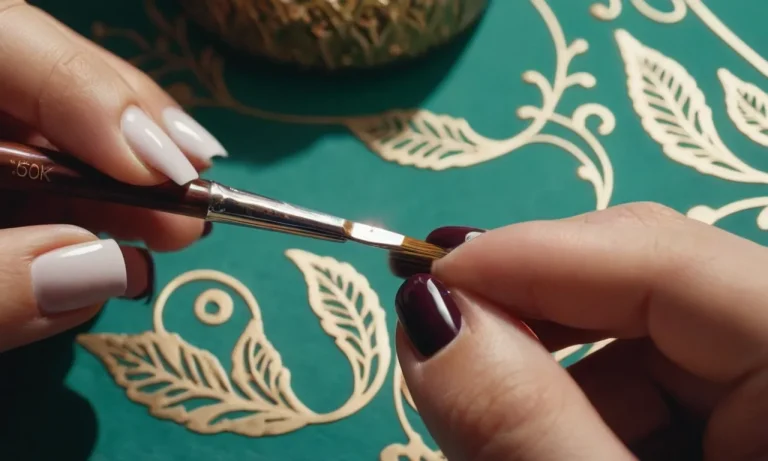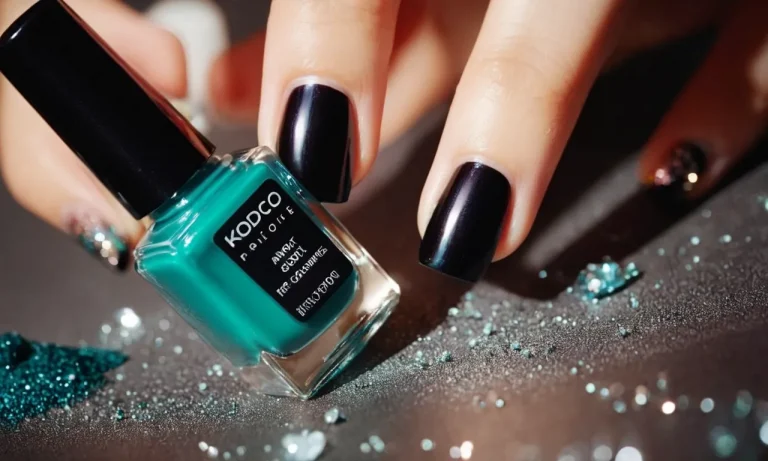How Much Do Nail Salons Make? A Comprehensive Look At Nail Salon Revenue
Getting a manicure or pedicure can feel like an affordable luxury. With services often costing $20-$50 each visit, most customers likely aren’t thinking about the bigger business perspective—how much money do nail salons actually make?
If you’ve ever wondered about the profitability of nail salons or considered opening your own salon, you’re in the right place. Here’s a quick answer: Most successful nail salons bring in $200,000 to $500,000 in revenue per year.
In this comprehensive guide, we’ll look at the average nail salon revenues and expenses, factors that affect profitability, how to improve your revenue, and considerations if you’re thinking about opening your own nail salon business.
Average Nail Salon Revenues
Service Pricing
Nail salon service prices can vary greatly depending on the type of service, location, and extras chosen. On average, a basic manicure costs $10-20, a basic pedicure $20-40, acrylic or gel manicures $30-50, and more elaborate nail art or designs $50-100+.
Many salons offer package deals for multiple services at a discounted rate. Prices are generally higher in metro areas and luxury salons.
Number of Customers
The number of customers a nail salon serves can range quite a bit. Most nail techs can handle 6-10 clients per day. Appointment-based salons may see 15-30+ clients daily with multiple techs on staff. Walk-in salons may see 50+ clients on a busy day.
High-end salons in metro areas can serve 100+ clients per day. The location, reputation, marketing, and staff size greatly impacts client volume.
Average Ticket Price
The average ticket price is the amount each customer spends per visit. This number factors in simple and deluxe services. Most nail salons see an average ticket price of $30-50. Higher-end salons may average $60-100 per client.
Factors like add-on services, nail art extras, and geographic location influence the average ticket amount.
Annual Revenue
Most successful nail salons bring in $150,000-$300,000 in gross annual revenues. Revenue is driven by location, reputation, marketing, service offerings, and staff productivity. Here’s a revenue breakdown example for an average nail salon:
- 20 customers per day x $40 average ticket = $800 daily revenue
- $800 daily x 6 days a week x 50 weeks a year = $240,000 annual revenue
Higher-end salons in metro areas may make upwards of $500,000 annually. Top salons can potentially gross $1 million+. Profit margins vary, but 25-40% profits are common for well-run salons.
Average Expenses for a Nail Salon
Salon Rent
One of the biggest expenses for a nail salon is rent. The average monthly rent for a nail salon ranges from $1,500-$5,000 depending on factors like location and size. Prime spots in busy areas like malls or downtown retail spaces command higher rents. Salons in residential neighborhoods may pay less.
Rent can easily eat up 20-30% of a salon’s total revenue.
Products & Supplies
Nail salons need constant resupplying of products like polishes, gels, acrylics, files, buffers, soaps, creams, and more. Supply costs vary based on the services offered but average 15-25% of revenue. Higher-end salons that use pricier branded products have steeper supply bills.
Buying in bulk helps lower costs, but quality should not be sacrificed. Top brands like OPI and Essie keep clients coming back.
Salon Equipment
Outfitting a salon with quality equipment is expensive upfront but pays off over time. Salon owners should budget at least $5,000-$10,000 on supplies like chairs, stools, tables, pedicure spas, sterilizers, and ventilation. Well-made salon furniture can last 5+ years with proper care.
Investing in advanced tools like electric nail files and paraffin wax machines also boosts service offerings.
Payroll
Staff payroll accounts for a whopping 50-60% of total expenses – the single biggest line item. Most salons employ a receptionist, 5-10 nail techs, and 1-2 managers/owners. Pay averages $10-$15/hour for new techs, $15-$25/hour for experienced techs, and $30K-$60K per year for managers.
Tipping policies allowing techs to take home 15-20% of service costs also impact payroll amounts. Smart scheduling keeps unused staff hours low.
Insurance & Permits
Salons must carry certain insurances like general liability ($1K-$2K per year) protecting against client injury claims. Extra policies like damage/theft, commercial auto, and business owner’s insurance also add costs but limit risk.
Licensing fees, taxes, necessary certifications and regular municipal inspections also tally a few thousand per year. Shopping insurance providers for group discounts trims this spend category.
Other Expenses
Additional overhead like advertising, accounting fees, credit card processing, music licensing, garbage pickup, cleaning services, electricity, and more should factor into financial planning. Marketing across social platforms and deals sites often yields best results for salons, but takes time invested.
Altogether salon owners must budget at least $3K per year on these ancillary expenses.
Balancing the books as a new salon owner challenges even savvy entrepreneurs. Carefully forecasting costs across all of these key spend areas provides the clarity needed to turn profitable within the first 1-2 years of opening doors.
Experienced salon managers also recommend keeping fixed expenses below 60% of gross receipts to maintain positive cash flow.
Factors That Affect Nail Salon Profitability
Location
The location of a nail salon plays a crucial role in its success. Nail salons located in areas with high foot traffic, such as busy shopping centers, main streets, and commercial districts tend to attract more walk-in customers.
The rent or real estate costs may be higher, but easy accessibility and visibility to potential clients make up for it.
Competition
Nail salon owners need to carefully assess the competition in the region. Opening a new nail salon right next to an established one will split the existing customer base. Analyzing the demographics and variety of services offered by competitors can help identify gaps and opportunities in the local marketplace.
Quality of Service
Consistently delivering excellent service quality helps build loyalty among customers. Investing in talented nail technicians and using premium products can justify slightly higher prices. Staying updated on the latest trends, techniques and hygiene standards also boosts reputation.
Customer Service
Exceptional customer service helps create repeat customers. Small gestures like greeting regulars by name, sending birthday cards, or giving loyalty rewards make clients feel valued. Handling requests, complaints and issues promptly also enhances the client experience.
Branding & Marketing
Creative branding and promotional strategies help attract new customers. Maintaining an updated website and profiles on directories like Yelp help with online visibility. Loyalty programs, holiday discounts or complimentary services also help with word-of-mouth and customer retention.
Operating Efficiency
Careful management of operating costs and inventory helps maximize profits. Monitoring product wastage, electricity usage and peak hours for staff scheduling allows minimizing expenses. The right balance of technicians to customers also ensures minimum idle time and increased revenue per nail station.
How to Increase Your Nail Salon Revenue
Offer Premium Services
One great way to boost revenue is to offer premium nail services that go beyond your standard manicure and pedicure. Consider providing gel manicures, paraffin wax treatments, hand and foot scrubs, and nail art. These value-added services allow you to charge higher prices.
For instance, a gel manicure may retail for $35 compared to a regular manicure at $15. This significantly increases your profit margin. Just be sure to invest in the proper supplies and training for technicians to perform advanced nail services.
Sell Retail Products
The right retail products can do wonders for your bottom line. Dedicate space in your salon to display high-quality nail polishes, tools, hand creams, foot scrubs, and more for customers to purchase. This makes it easy for them to continue caring for their nails at home while generating ancillary revenue for your business.
Employ smart merchandising strategies like placing products near checkout and training staff to promote specials. It’s also wise to carry professional brands that clients can’t buy at drugstores. This incentivizes add-on purchases each visit.
Run Promotions and Loyalty Programs
Getting new customers through the doors is important, but retaining existing patrons is critical too. This is where promotions and loyalty programs come in handy. For example, you could offer first-time visit discounts or birthday specials to hook new guests.
Popular deals like buy-one-get-one half off are sure to delight as well. To keep customers coming back, create a punch card rewards system. After a certain number of services, clients earn a free mani-pedi or product credit. This makes them feel valued while promoting repeat business.
Expand Your Services
Once your nail salon is running smoothly, look for opportunities to expand your offerings. For instance, you could bring on specialists for eyelash extensions, facials, spray tanning, waxing, and more. This transforms your business into a one-stop beauty shop.
The advantage is you can cross-sell clients on multiple services during each appointment. Someone who comes in for a fill may also book a facial or wax. Opening secondary revenue streams helps maximize earning potential.
Invest in Marketing
Getting the word out about your fabulous nail salon is a must. Be sure to cover the basics like professional signage outside your location as well as a user-friendly website and active social media profiles. Yet don’t be afraid to get creative with marketing too.
Sponsor local events to gain community exposure. Run giveaways and contests to build engagement. And partner with neighborhood businesses on co-promotions. The more people who learn about your salon, the more revenue you can generate. So put some budget toward smart advertising.
Optimize Operations and Staffing
Finally, analyze your operations to identify any areas for improvement. Are technicians fully booked all day or do you notice appointment gaps? Is the checkout process fast and efficient? Do retail displays quickly need restocking? Pinpoint problems then implement solutions.
Likewise, make sure staffing levels appropriately match demand. Technicians churning out services nonstop with a steady stream of clients means you need more hands on deck. Hire additional employees so you can accommodate volume rather than turn business away.
Optimizing operations and staffing helps maximize earning potential.
Considerations Before Opening a Nail Salon
Required Licenses and Training
Opening a professional nail salon requires obtaining the proper licenses and training to legally and safely operate. The fabulous professionals at nail salons need to have a current cosmetology or nail technician license in accordance with state board regulations.
Achieving the 500-600 hours training at accredited beauty schools to pass this licensing exam ensures spectacular sanitation and application skills.
Startup Costs
Launching an awesome nail salon demands significant startup funds, averaging $50,000-100,000 for essential equipment like professional nail tables and chairs, sterilization tools like autoclaves, air purifiers to control product fumes, and industry-grade polishes and acrylics.
With careful research and planning, fabulous entrepreneurs can secure small business loans or personal investments to cover these phenomenal beginning expenses.
Finding a Good Location
An ideal location with plentiful parking and storefront visibility can make or break a new nail salon. Smart research into local income levels, area competition, and pedestrian traffic patterns helps determine the most phenomenal neighborhoods for success.
Signing a 2-3 year lease also locks in stable monthly rent payments during the early years of business growth.
Hiring Staff
Building an exceptional team of licensed manicurists and pedicurists requires competitive pay rates, thorough interviewing, and background checks. Paying the industry average wage of $11-15 per hour attracts applicants with existing clientele and motivates high retention.
Requiring at least 2 years experience and checking references also ensures the hiring of fabulous nail technicians invested in quality service.
Establishing Your Brand
Creating a fabulous brand identity with logos, website, and marketing materials gives a new nail salon an advantageous edge. Investing in professional branding conveys quality services and helps attract phenomenal customers.
Unique names, taglines, and logos that reflect the vision of the business also aid tremendously with community recognition and loyalty.
Creating a Business Plan
Every smart entrepreneur needs a detailed business plan before launch, outlining financial goals, startup costs and funding sources, equipment and inventory investments, and growth milestones for the first few years.
This keeps the fabulous business owner organized and on track, while also serving as a guide for managing expenses and measuring success. With dedication and perseverance, most independent nail salons see full return on investment and reach profitability within 1-3 years.
Conclusion
While running a profitable nail salon takes hard work and strategic planning, the potential rewards can make it a worthwhile business venture. With the right location, excellent customer service, talented staff, and effective branding and marketing, most nail salons can achieve $200,000 to $500,000 in annual revenues.
Carefully tracking your expenses, finding ways to boost revenue through upselling and promotions, and analyzing your profitability compared to industry benchmarks can help you operate a successful salon.
If you’re considering opening your own nail salon, following a thoughtful business plan and understanding all the startup costs and operational details are key. With passion for the industry and sound business practices, operating a nail salon can be a fulfilling and financially viable career path.







